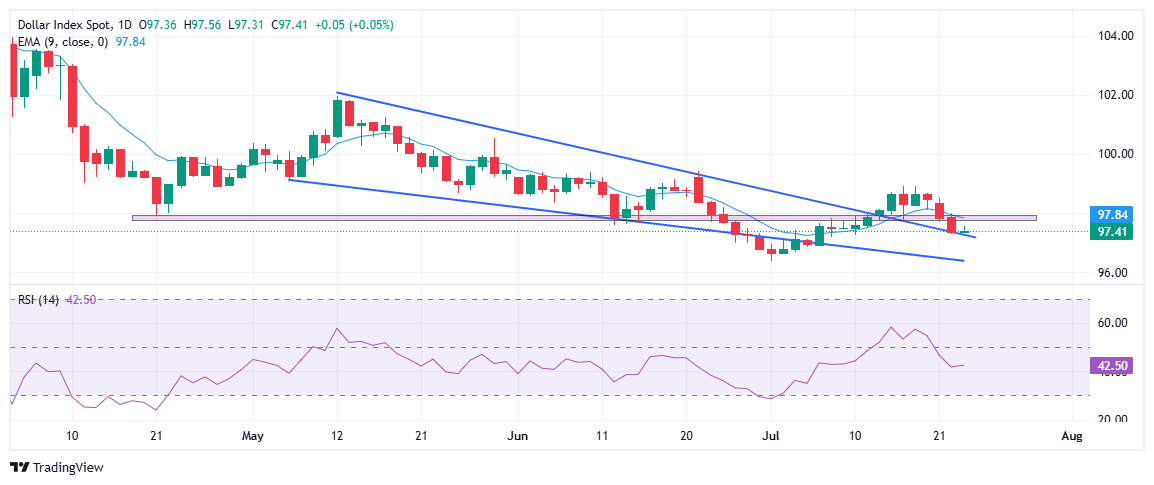US Dollar steadies as markets weigh US-Japan deal
- The US Dollar stabilizes on Wednesday after a sharp three-day decline.
- US President Donald Trump announces a $550B trade deal with Japan, easing trade tensions.
- Political pressure mounts on Fed Chair Powell; Trump calls him a “numbskull.”
The US Dollar (USD) steadies on Wednesday after a rough three-day decline. Traders seem to be taking a breather as tensions around global trade ease somewhat after the US and Japan reached a trade deal ahead of the looming August 1 tariff deadline. At the same time, growing political heat on the Federal Reserve (Fed), with fresh criticism aimed at Chair Jerome Powell, has reignited concerns over the central bank’s independence, keeping market sentiment fragile and the Greenback on the back foot.
The US Dollar Index (DXY), which gauges the Greenback’s strength against six major peers, is holding steady near 97.40 in Wednesday’s American trading session, pausing after a sharp pullback from near four-week highs. The index is down around 1.10% so far this week as traders turn cautious and await more clarity on trade talks.
US President Donald Trump fueled cautious optimism on Tuesday after announcing what he called a “massive” trade deal with Japan, describing it as “perhaps the largest deal ever made.” The United States and Japan have reached a new trade agreement that reduces the previously proposed 25% tariffs on a wide range of Japanese goods to a lower 15% rate. According to Trump, Japan will invest $550 billion in the United States, with 90% of the profits expected to return to American industries. He also claimed the agreement would create “hundreds of thousands of jobs” and open up Japanese markets to US exports, including cars, trucks, rice and agricultural products.
The deal has helped ease fears of a broader trade escalation ahead of the August 1 deadline and sparked optimism that Washington may pursue similar negotiated outcomes with other trading partners. However, with other negotiations still unresolved, especially with India and the European Union (EU), uncertainty continues to hang over the US Dollar’s near-term outlook.
Market movers: Global trade deals take shape as tariff deadline nears
- On Tuesday, President Trump announced a 19% tariff on imports from the Philippines. In return, the US secured zero tariff access for a wide range of American goods.
- Under a new framework, the US has agreed to lower tariffs on Indonesian goods to 19% from the previously proposed 32%. However, goods suspected of being "transshipped" to avoid higher duties from other countries will be subject to a 40% tariff. In return, Indonesia has committed to eliminating tariffs on over 99% of US products exported to Indonesia and scrapping non-tariff barriers.
- EU Trade Commissioner Maros Sefcovic arrived in Washington on Wednesday for talks aimed at negotiating sweeping US tariffs of up to 30% on European goods. With the August 1 deadline fast approaching, Brussels is pushing for a trade deal to avoid high tariffs, while preparing retaliatory measures in case the talks fail to progress.
- Trade Secretary Scott Bessent is expected to meet with Chinese officials next week in Stockholm. He also signaled that the current tariff truce with China is likely to be extended ahead of its expiration on August 12.
- President Trump said earlier that a trade deal with India is close, but talks remain stalled. According to Reuters, hopes for a smaller agreement between the US and India before the tariff deadline have faded with major differences over agricultural and dairy products. While US representatives are expected to visit India later in July, the delay raises the risk of fresh tariffs on Indian exports.
- Fed Chair Jerome Powell remains under fire after President Trump renewed public attacks, calling him a "numbskull" and suggesting he will be gone in eight months. Meanwhile, Scott Bessent stated in an interview on Tuesday that there is nothing that suggests he should resign. He acknowledged Powell as a good public servant and indicated that Powell should continue his term, which ends in May 2026.
Technical Analysis:

The US Dollar Index (DXY) is treading water near 97.40 after a sharp pullback from its recent highs. Price is currently hovering just below the upper boundary of a falling wedge pattern, which had previously been breached to the upside but is now being retested as potential support-turned-resistance. This kind of wedge retest is often pivotal. If bulls fail to reclaim the broken structure with conviction, it could signal a false breakout and shift the technical tone back to bearish. The 9-day Exponential Moving Average (EMA), now trending slightly above at 97.84, adds to the pressure capping the upside.
The Relative Strength Index (RSI) has dipped to 42.50, indicating a fading of momentum and a lack of strong buying conviction. If the index can bounce from current levels and reclaim both the wedge and the 98.00 psychological barrier, bullish momentum may resume. However, a clean rejection from this zone could expose the DXY to a deeper drop toward the next support band around 96.70-96.50.
